XFX’s Radeon HD 7970 Black Edition Double Dissipation: The First Semi-Custom 7970
by Ryan Smith on January 9, 2012 6:00 AM ESTThe Test, Power, Temp, & Noise
| CPU: | Intel Core i7-3960X @ 4.3GHz |
| Motherboard: | EVGA X79 SLI |
| Chipset Drivers: | Intel 9.2.3.1022 |
| Power Supply: | Antec True Power Quattro 1200 |
| Hard Disk: | Samsung 470 (240GB) |
| Memory: | G.Skill Ripjaws DDR3-1867 4 x 4GB (8-10-9-26) |
| Video Cards: |
XFX Radeon HD 7970 Black Edition Double Diss. AMD Radeon HD 7970 AMD Radeon HD 6990 AMD Radeon HD 6970 AMD Radeon HD 6950 AMD Radeon HD 5870 AMD Radeon HD 5850 AMD Radeon HD 4870 NVIDIA GeForce GTX 590 NVIDIA GeForce GTX 580 NVIDIA GeForce GTX 570 NVIDIA GeForce GTX 470 NVIDIA GeForce GTX 285 |
| Video Drivers: |
NVIDIA ForceWare 290.36 Beta AMD Catalyst Beta 8.921.2-111215a |
| OS: | Windows 7 Ultimate 64-bit |
We’ll start things in reverse today by first looking at the power, temperature, & noise characteristics of the 7970 BEDD. The custom cooler is the single biggest differentiating factor for the BEDD, followed by its factory overclock.
| Radeon HD 7900 Series Voltages | ||||
| Ref 7970 Load | Ref 7970 Idle | XFX 7970 Black Edition DD | ||
| 1.17v | 0.85v | 1.17v | ||
As we noted in our introduction, the BEDD ships at the same voltage as the reference 7970: 1.17v. Since XFX is using the AMD PCB too, the power characteristics are virtually identical, save for the overclock and the power draw of the two fans.
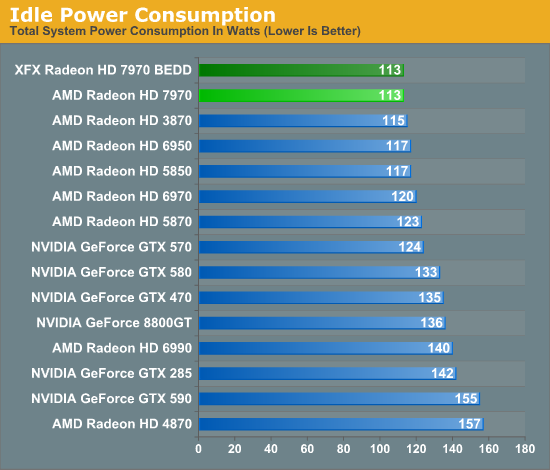
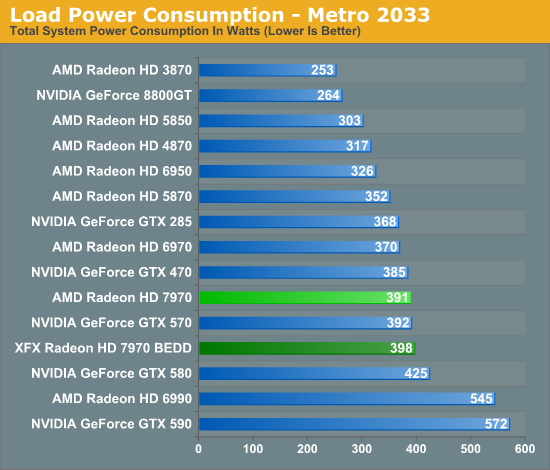
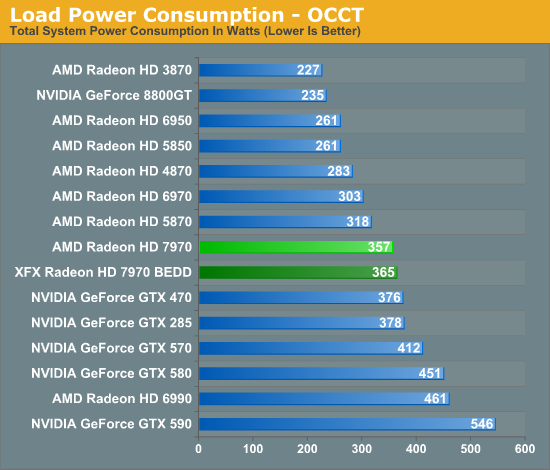
Even with two fans the idle power consumption of the BEDD is identical to the reference 7970. Meanwhile under load we see that the power consumption for the BEDD creeps up slightly compared to the reference 7970. With Metro 2033 we see system power consumption peak at 398W, 7W over the reference card, meanwhile under OCCT system power consumption peaks at 365W, 8W over the reference card.
It’s worth noting that as XFX has not touched the PowerTune limits for the BEDD, it’s capped at the same 250W limit as the reference 7970 by default. So far we haven’t seen any proof that the BEDD is being throttled at this level under any of our games or compute benchmarks, however we can’t completely rule this out as we still don’t have any tools that can read the real clockspeed of the 7970 when PowerTune throttling is active. Whenever an overclock is involved there’s always a risk of hitting that PowerTune limit before a card can fully stretch its legs, hence the need to be concerned about PowerTune if it hasn’t already been adjusted. As for our power tests, the difference seems to largely boil down to the higher power consumption of XFX’s fans when they’re operating above idle.

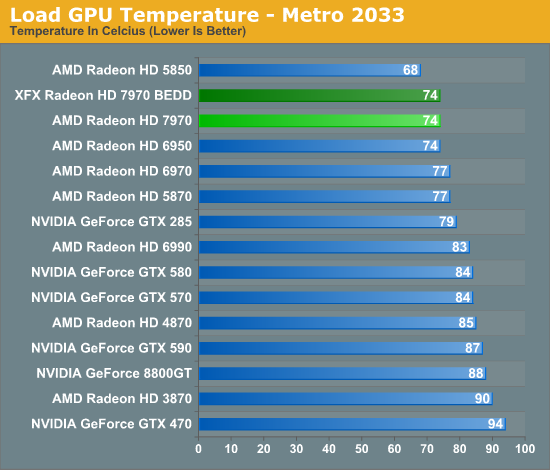
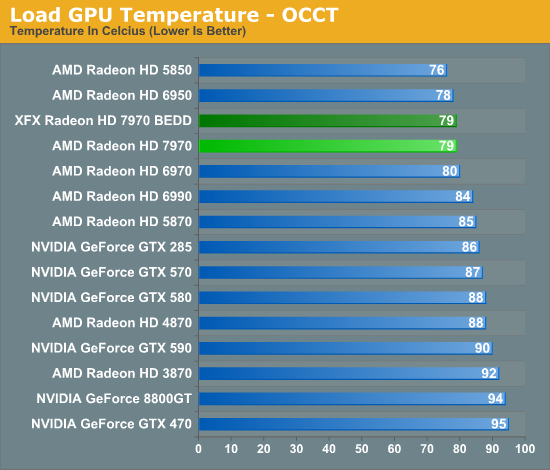
One of the key advantages of open air designs is that they do a better job of dissipating heat from the GPU, which is what we’re seeing here with the BEDD under idle. At 30C the BEDD is 4C cooler than the reference 7970, with all of that being a product of the Double Dissipation cooler.
However it’s interesting to note that temperatures under load end up being identical to the reference 7970. The BEDD is no cooler than the reference 7970 even with its radically different cooling apparatus. This is ultimately a result of the fact that the BEDD is a semi-custom card; not only is XFX using AMD’s PCB, but they’re using AMD’s aggressive fan profile. At any given temperature the BEDD’s fans ramp up to the same speed (as a percentage) as AMD’s fans, meaning that the BEDD’s fans won’t ramp up until the card hits the same temperatures that trigger a ramp-up on the reference design. As a result the BEDD is no cooler than the reference 7970, though with AMD’s aggressive cooling policy the reference 7970 would be tough to beat.
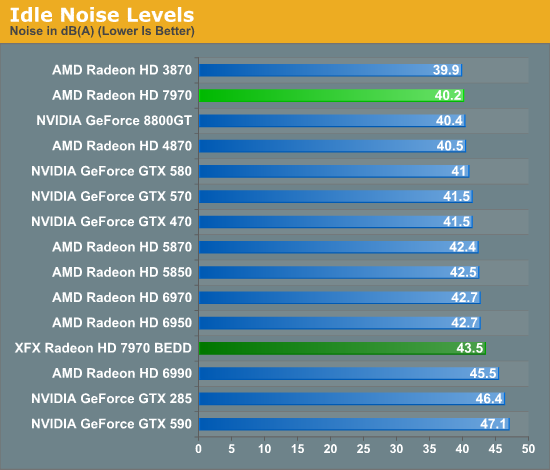
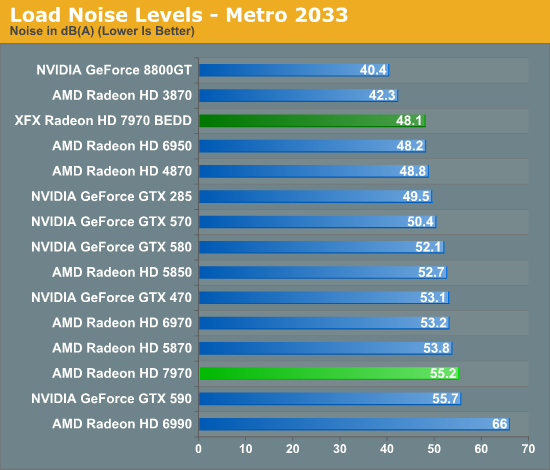
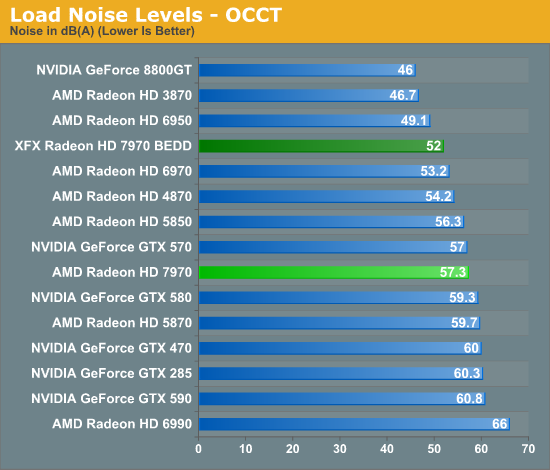
Finally taking a look at noise we can see the full impact of XFX’s replacement cooler. For XFX this is both good and bad. On the bad side, their Double Dissipation cooler can’t match the 7970 reference cooler when idling; 43.5dB isn’t particularly awful but it’s noticeable, particularly when compared to the reference 7970. Consequently the BEDD is definitely not a good candidate for a PC that needs to be near-silent at idle.
On the flip side under load we finally see XFX’s cooler choice pay off. AMD’s aggressive fan profile made the reference 7970 one of the loudest single-GPU cards in our lineup, but XFX’s Double Dissipation cooler fares significantly better here. At 48.1dB under Metro it’s not only quieter than the reference 7970 by a rather large 7dB, but it’s also quieter than every other modern high-end card in our lineup, effectively tying with the reference 6950. Even under our pathological OCCT test it only reaches 52dB, 5dB quieter than the reference 7970.
Ultimately where the BEDD was a poor candidate for noise under idle, it’s an excellent candidate for a quiet computer under load thanks to the open air nature of XFX’s Double Dissipation cooler, and certainly the launch card to get if you want a load-quiet 7970. Just don’t throw it directly up against another card in CrossFire, as these open air cards typically fare poorly without an open slot to work with.










93 Comments
View All Comments
Duraz0rz - Monday, January 9, 2012 - link
I don't think GCN, a completely new architecture, would qualify as an "old graphics solution".Morg. - Tuesday, January 10, 2012 - link
1. yes no reason to go further than a good 5850 right now . (I still have a 4850 and it's just gone into the 'bit too shitty' zone for me)2. 6950 murders a 5850, and the new 7-series does the same to the 6-series.
3. The architecture just changed on AMD side, towards more of a vector processor, just like nVidia's Fermi, this is a good thing for compute and the future of IT in general (heterogeneous core blabla and stuff). (by the way, GCN is not all that new, it's just an adaptation of an older design)
4. Obviously, all that power is becoming a bit useless to gamers since game devs have shifted most of their focus to consoles, and the last big PC game dev (blizzard) focuses on delivering "playable" games for everyone, thus limiting the computing requirements.
5. This is 2011, You can expect that shading and tesselation will eventually enable games to look as good as your hardware can make them, with graphics settings limited to how many FPS minimum and average you want. This is especially true since future consoles will have some of that . and the next round even more.
I'd expect that kind of stuff to be mainstream around 2013 - 2014, so if you're going to keep your new box for 3 years, why not ... (on the other hand, the best graphics board for money currently still is the 6950 of course...).
And .. the tiny bit of truth : yes the gtx 580 is what the 480 was meant to be, with quite a few glitches fixed. It's obviously not meant for a 40nm process (500+ Watts in basic overclocking is a bit much) and that was part of nVidia's strategy : develop fermi on 40 nm then port it to its intended size : 28nm.
AMD waited for 28nm and I believe that was the best choice, seeing how they managed to deliver (much more easily than Fermi by the way .. which had major issues for its first release).. Just looking at the power requirements for the 7970 tells the whole story . That thing is downclocked to hell just to remain under 300 Watts ...
theprodigalrebel - Monday, January 9, 2012 - link
Should come with a warning: No motorboating the cardIceDread - Tuesday, January 10, 2012 - link
I purchased XFX radeon hd 5970 a couple of years ago. XFX are inferior when it comes to overclocking. They were more restrictive and values had to be adjusted each restart even if I remember correctly.The result was that everyone who wanted to overclock their xfx cards installed firmware from other companies to successfully be able to overclock their cards.
piroroadkill - Tuesday, January 10, 2012 - link
This was true for me, too. I had an XFX 4890 (which is dying now, despite running at stock for a long time).It had a custom (and worse) vrm section of the board, and didn't overclock worth a single damn. Those promises of 1GHz 4890s? Haha, not if you owned one of these.
Mjello - Tuesday, January 10, 2012 - link
Is it possible to control the fan manually. That would fix the idle noice easilywifiwolf - Tuesday, January 10, 2012 - link
The article stated it's already at its minimum rate since it's using the same controller as the reference card.fausto412 - Tuesday, January 10, 2012 - link
Can we get more detail info on this newly added tech?I read the AMD whitepaper buy I am curious as to real world impact of it.
Ryan Smith - Tuesday, January 10, 2012 - link
Actually PowerTune is not new. It was first introduced on Cayman (6900 series); the Tahiti (7900 series) implementation is no different.http://www.anandtech.com/show/4061/amds-radeon-hd-...
dcompart - Tuesday, January 10, 2012 - link
It'd be nice to see the overclock performance of a standard cooled card for comparison. I'd like to be able to balance the price justification not only on noise but performance. The comparison between a regular 7970 against a stock overclocked card doesn't persuade me, then it irritates me further to see the XFX overclocked further, without even playing devils advocate and showing the overclock potential of a regular 7970 with standard cooling. It doesn't make want to buy the Overclocked card, it makes me feel deceived!